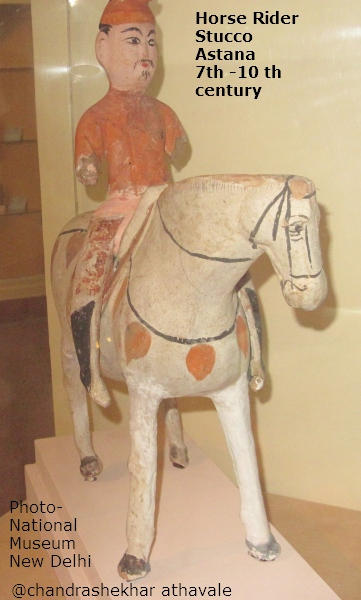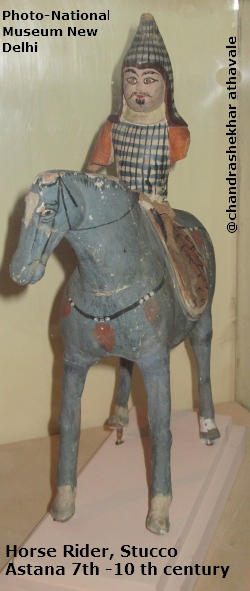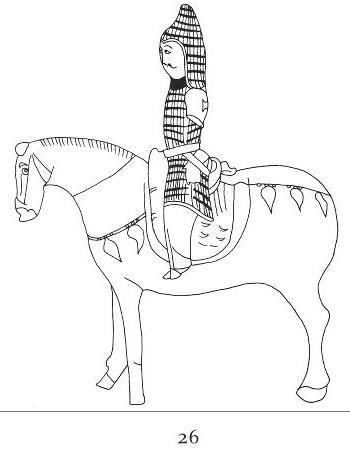|
Clay Figurines of Cavalrymen, Astana, Central Asia, 7th-10th Centuries
Clay Horses with riders
Stein found in one of the Astana graves, an anteroom, next to the tomb.
He writes, “In the niche on the opposite side and in front of the tomb, there lay in confusion an assortment of figures of clay horses of smaller size,
with figures of riders either still adhering to them or alongside. Careful representation of the saddlery of the horses is of special interest.
It includes narrow high-peaked saddles placed on tiger-skin saddle-cloths and white Numdahs (embroidered special rug made in Kashmir and Xinjiang),
with straps flowing from the back of the saddles, just as they appear in sculptures and paintings of T’ang times.
Among other items of horse-millinery, notice may be taken of the elaborate decoration of the trappings with large tassels.
The figures of the riders are with one exception, those of men, dressed either in scale-armour and pointed helmet of mail or in tight-fitting coats with high-lobed caps,
and of the quasi-archaic dress of certain figures represented in scenes from Buddha’s life.
The faces, though perfunctorily modelled and painted, are of unmistakably Chinese type.”

Stein describes this Clay figure of man rider as, “Head and body moulded on pointed stick core, which passed below into hole in back of horse, fixing rider upright in saddle.
Legs moulded without core in convex curve, flat on inside, to grip sides of horse, but now broken from body.
Arms (so far as preserved) straight by side, but broken off above elbow. Dressed in tight-fitting vermilion coat reaching to knee and black top-boots edged with white.
Skirts of coat sprinkled with spot rosettes in brown. Hair short, black.
Cap close fitting, red at lower part in front, passing into narrow red band at back above lower edge of cap, which is of the high-lobed crown type, with red bow in front.
Lobe is cleft in front. Face painted pink, with black for eyes, eyebrows, moustache, and small beard ; crimson on lips.
Features rather perfunctory. Head broken from body, and general condition somewhat worn. Height 10¼".
Clay horse, painted white and in good condition. Left foreleg extant but broken off. Head turned to Left.
Tiger-skin Numdah (embroidered special rug made in Kashmir and Xinjiang), and green saddle with five hanging straps indicated on near side and four on off side.
Black headstall and trappings with orange tassels ; orange and black mane ; black hooves. Mark of clay tail, broken off. Height 10".”
Stein: plate CII

Stein’s detailed description follows as “Clay Figure of man rider, arms lost from above elbow and legs broken from body.
Coat pale yellow ; boots or shoes black ; leggings from ankle to knee white with dot and circle decoration in black. Black stirrup-leather passing down front of legs,
and pale yellow stirrup. Vermilion bow and band round cap ; but vermilion band down to lower edge of cap at back. Fair condition. Height 10½".
Clay horse painted blue ; Near hind leg and tips of ears missing ; otherwise in good condition.
T’ang type, broad chested with slim legs, full body, large rounded hind quarters, thick arched rather short neck, and small head.
Latter turned slightly to right. Fetlocks painted white, and hooves pale blue ; triangular white patch on forehead ; hogged mane and forelock painted black ; tail missing.
Tiger-skin saddle-cloth in vermilion and black over white Numdah (embroidered special rug made in Kashmir and Xinjiang) ;
black saddle with high pointed front and somewhat lower rounded back. Saddle unpainted where covered by person of rider, and with hole in middle for insertion of stick core.
On both sides of saddle-cloth and issuing from back of saddle five black lines representing flowing straps.
Headstall and single rein (which is attached to throat-lash) painted in black.
No girth shown, but narrow black breast-band and crupper painted in black and decorated with groups of three white spots from which hang vermilion tassels.
Four sticks, forming core of legs, project 1" below hooves for fixing horse in ground. Height to crown of head 10¼".”
Stein: plate XCIX
Source: Gems from the National Museum: Sir Aurel Stein collection
Referenced as Figure 26 in David Nicolle, "An introduction to arms and warfare in classical Islam", in: Islamic Arms and Armour, ed. Robert Elgood, London 1979

Fig. 26. Clay figure of rider from Astāna cemetry, eastern Turkestan.
According to the Byzantine Emperor Leo VI the nomad Turks were equipped with cuirass, sword lance and bow, the horses of their leaders wearing iron or leather armour (figs. 26-27).
Referenced as figure 451 in The military technology of classical Islam by D Nicolle
451. Clay statuette from Astāna, 7th-8th centuries AD, east Turkistānī, British Museum (Stein S).
|